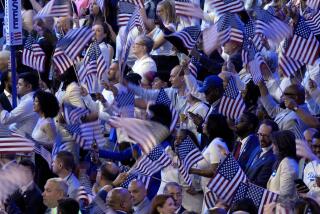Buying Glory Is Nothing New
- Share via
Walk through any mall and you still see them: the flag T-shirts, the patriotic picnic ware, the USA-emblazoned tongue rings. In post-Sept. 11 America, there are enough bright-starred, broad-striped products to stretch from sea to shining sea.
But if you’re tired of seeing Old Glory used as a marketing tool--or stuck on people’s backsides or dangling from key rings--take heart. Although the stores are filled with red, white and blue for the Fourth of July holiday, the public’s interest in outward signs of patriotism may be waning--being replaced, perhaps, by a more enduring interest in things American.
“I have a ‘flag-o-meter,’ and I’m seeing a lot fewer these days,” says Tom Holliday, president of the Washington-based Retail Advertising and Marketing Assn. “I’ve been seeing a lot of patriotic merchandise marked down.” The flag decal in the back of Holliday’s car is beginning to curl because of the sunlight, he says, and he won’t replace it. “But that’s not because I’m feeling any less patriotic.”
Interestingly enough, there’s been no real effort to “buy American” since Sept. 11, in spite of people’s newfound patriotism. “We realize globalization is here to stay,” says Cary Silvers, vice president of Roper Reports, a New York-based consumer trend service. If nothing else, it’s hard to buy American. The four-poster bed you’ve fallen in love with may be made in North Carolina, but the bedposts came from South America.
So what about all the fashion and furniture with American themes we’ve been seeing in the last nine months? What about the meatloaf and garlic mashed potatoes that can now be found on hip restaurant menus?
Many things can be attributed to the terrorist attacks, but probably not these. Take the retro American dishes that have become so trendy. While some argue that Americans turned to comfort food in response to war and terrorism, its popularity really took off in the ‘90s. In a survey conducted for Advertising Age, published in March, 84% of respondents said their buying patterns for food have remained the same since Sept. 11, while 77% reported eating the same amount of comfort food as before.
The events of Sept. 11 seem to have simply accelerated a trend toward Americana in home, fashion and food that was already on a roll. Even the enormous amount of patriotic material we’re seeing in the stores now may only partly be a response to Sept. 11. After all, Americans have been decorating their homes more and more for the holidays in the last few years.
“There was a lot of Americana out there pre-9/11,” says Diane Daly, director of fashion and communications at Hecht’s, pointing out that popular designers such as Tommy Hilfiger and Ralph Lauren have always specialized in it. Flag-inspired beaded evening bags were in stores before the tragedy.
Perhaps it all comes down to a different definition of patriotism than the experts first thought. Silvers believes that one of the most lasting lifestyle changes since the Sept. 11 attacks may be that patriotism is making us examine our roots. A recent Roper survey showed that more people are traveling within the United States this summer for safety reasons, but Silvers believes Americans are also newly interested in visiting historic sites. “When you tell the rest of the world you’re proud to be an American,” he says, “you have to know what you stand for.”
*
Elizabeth Large writes for the Baltimore Sun, a Tribune company.
More to Read
Eat your way across L.A.
Get our weekly Tasting Notes newsletter for reviews, news and more.
You may occasionally receive promotional content from the Los Angeles Times.










